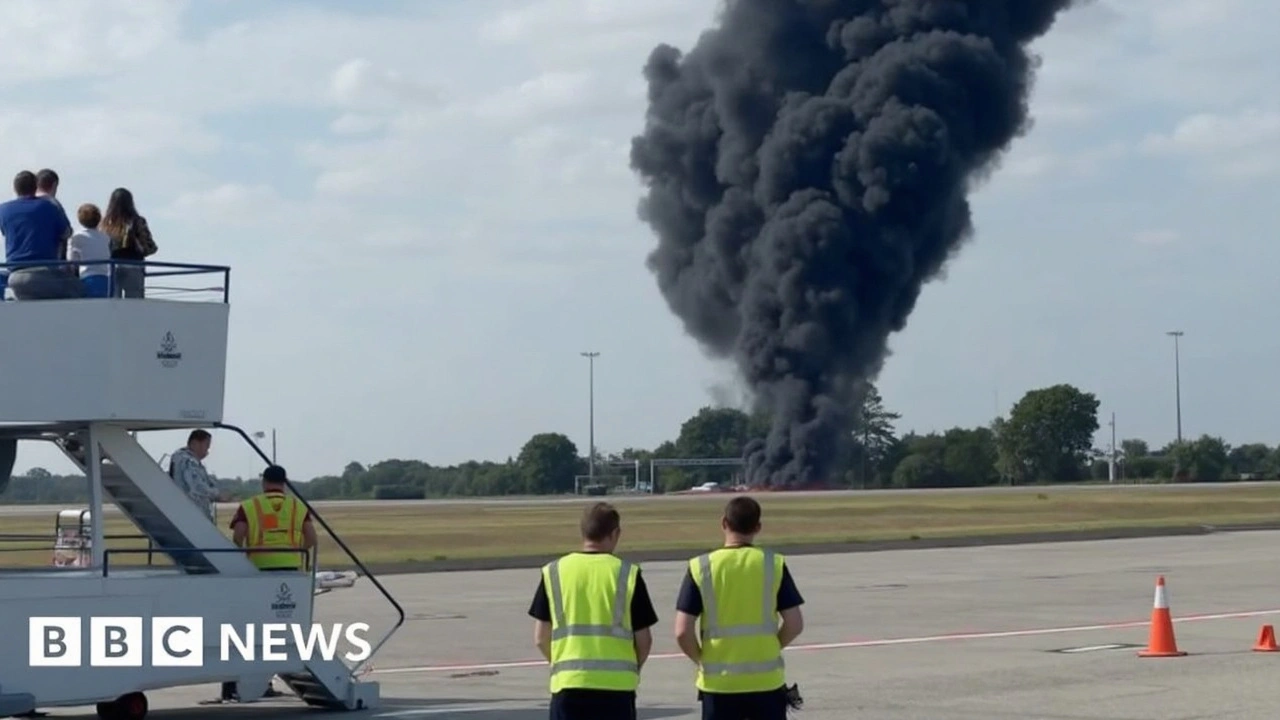Southend Airport Plane Crash: Medical Transport Mission Ends in Tragedy, All Flights Suspended

Medical Transport Plane Crash Sends Shockwaves Through Southend Airport
Imagine looking up to see a small aircraft climbing away from Southend Airport, then, without warning, watching it flip upside down and plummet nose-first into the ground—and then a blinding fireball. That’s exactly what witnesses saw just after 3:48 PM on July 14, 2025, as a Beechcraft B200 Super King Air operated by Zeusch Aviation crashed moments after takeoff. The crash killed all four people on board, shattering a routine medical transport into a tragedy that has left many reeling.
The twin-turboprop aircraft, which had just dropped off a patient in the UK after flying in from Croatia, was beginning its flight back to the Netherlands. The plan appeared straightforward, but something went terribly wrong during the climb. Eyewitness John Johnson said the plane "banked sharply left" before pitching nose-down and exploding on impact, turning the routine takeoff into a scene of horror as the wreckage burst into a "huge fireball." Debris scattered across the runway and emergency alarms rang out across the airport.
Among those lost were two experienced Dutch pilots, a 31-year-old Chilean nurse named Maria Fernanda Rojas Ortiz—widely known as Fena—and a male doctor whose identity had not yet been publicly confirmed. Each member of the medical team had just helped transport a patient to safety, only to lose their own lives on the return journey. Recovery teams found three bodies in the charred remains, and the search continued for the last victim under challenging conditions.

Airport Lockdown and Scramble for Answers
In an instant, Southend Airport shut down all operations. Every flight for the rest of Monday was canceled or rerouted, with passengers scrambling to contact airlines for new arrangements. The terminals quickly emptied as police officers and firefighters moved in, cordoning off the airfield and pleading with the public to stay away. For those trying to travel, the only advice was to monitor airline updates and brace for uncertainty as the airport closure stretched into an indefinite timeline.
Authorities moved fast. Essex Police declared a "serious incident," and emergency services arrived in force—ambulances, fire trucks, and specialized rescue units converged on the scorched crash site. The response was methodical and intense: immediate recovery efforts, support for witnesses and airport staff, and a swift beginning to what is sure to be a complex investigation.
The Air Accident Investigation Branch (AAIB) took charge of the technical analysis, collecting wreckage and flight data to piece together just what happened in those fateful moments after takeoff. Early reports focused on the plane’s unusual inverted position and sharp bank, both rare for a twin-prop on departure. This suggests a sudden and catastrophic malfunction, but investigators are keeping all possibilities open as they sift through the evidence.
Those in the world of medical aviation know that outings like this are both common and critical—doctors, nurses, and pilots work as tight-knit crews to save lives. July 14th was supposed to be another successful mission; instead, it’s a day that will be marked by heartache and searching questions about safety and fate in the skies.
As the airport stays closed and the community waits for answers, the scars—both physical on the airfield and emotional among the staff, families, and witnesses—are already deep. For now, Southend Airport is silent, marked by grief and the relentless work of investigators trying to prevent the next tragedy.
The preliminary report from the AAIB indicates that the flight data recorder captured a sudden loss of engine power approximately twelve seconds after rotation. The aircraft’s bank angle reached an abnormal 45 degrees to the left before the nose pitched down sharply. Investigators are examining the propeller control units and the hydraulic systems for any signs of malfunction. Witness accounts corroborate the rapid roll, which is atypical for a Beechcraft B200 during climb. It is essential that the maintenance records be reviewed thoroughly to rule out systemic issues.
The skies over Southend that afternoon turned from routine to nightmarish in the blink of an eye. A humble twin‑engine King Air, which had just delivered a life‑saving patient across borders, suddenly betrayed its purpose. As the propellers churned, the aircraft lurched left, as if an invisible hand had yanked the wing. The nose dipped, and the world seemed to hold its breath before the metal plunged into the tarmac. A sudden, blinding fireball erupted, casting an eerie orange glow over the runway that will haunt witnesses for years. The ground crew, frozen in shock, could only watch as the wreckage shattered like glass. In those harrowing seconds, the four souls aboard - two seasoned pilots, a compassionate nurse, and a dedicated doctor - were thrust from a mission of hope into an irrevocable abyss. Their sacrifice reverberates beyond the immediate tragedy, reminding us of the fragile thread that connects life and death in medical aviation. Families back in the Netherlands and Chile now mourn in a silence punctuated only by the hum of distant aircraft. The airport’s abrupt shutdown turned a bustling terminal into a ghost town, with passengers stranded and airlines scrambling for alternatives. Yet amid the turmoil, first responders displayed unwavering professionalism, cordoning the site and beginning the painstaking recovery. The AAIB’s involvement promises a meticulous dissection of every bolt and circuit board, hunting for that single point of failure. While speculation swirls - weather anomalies, mechanical fatigue, human error - the investigation remains the only beacon of truth. This calamity also raises broader questions about the safety protocols governing cross‑border medical flights, especially those operating on tight schedules. As the community gathers to honor the fallen, we must also demand rigorous standards to prevent another night like this from ever unfolding again.
From an avionics standpoint, the negative G‑load during the abnormal roll likely exceeded the structural limit of the wing spars. Flight data suggests a transient loss of manifold pressure, which could indicate a fuel‑pump anomaly. The B200’s dual‑engine interconnect system is designed to mitigate single‑engine failures, but a cascade failure might have disabled both propulsors simultaneously. Aerodynamic stall recovery procedures would have been compromised by the aircraft’s low altitude and high pitch rate. Moreover, the aircraft’s weight‑and‑balance calculations, especially after a patient transfer, could have contributed to a center‑of‑gravity shift. Correlating the ELT beacon timestamps with radar plots will be crucial for reconstructing the flight path.
Such a catastrophic event underscores the negligence in pre‑flight checks that should never be overlooked.
Wow, what a tragic turn of events! The crew were absolutely on point, and now they’re gone-truly heartbreaking. I think the industry needs to step up its game and make sure every checklist is double‑checked, no excusess. Maybe more rigorous training on emergency procedures could help prevent teh next disaster. Let’s hope the investigation brings some answers and that future missions are safer for everyone involved.
The circumstances surrounding the crash warrant a comprehensive review of operational protocols, as the current framework appears deficient in addressing critical failure scenarios. It is incumbent upon regulatory bodies to enforce stricter compliance measures to mitigate such preventable losses.
While the investigation will reveal technical causes, accountability for procedural lapses must not be ignored.
Team, remember that resilience is built on learning from these painful incidents; study the AAIB preliminary findings, integrate the risk mitigation strategies into your pre‑flight briefings, and keep the safety culture front‑and‑center.
The media’s sensationalism will only distract from the sobering technical realities of this crash.